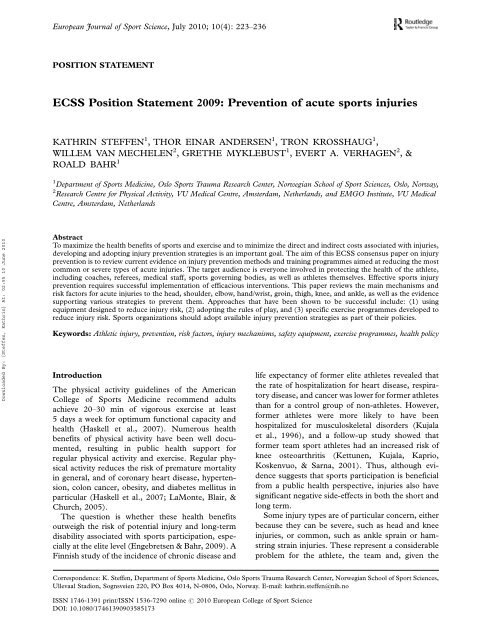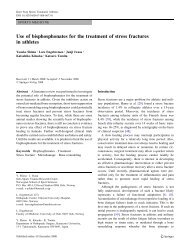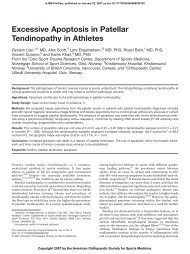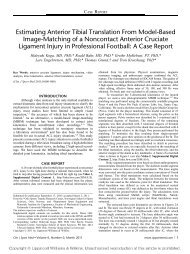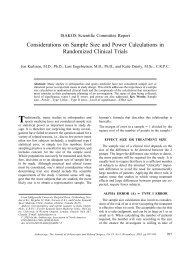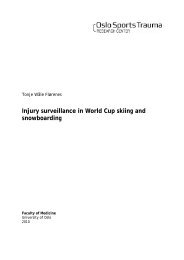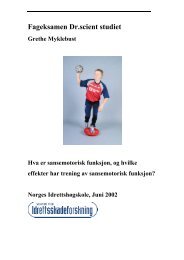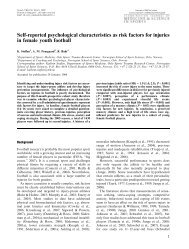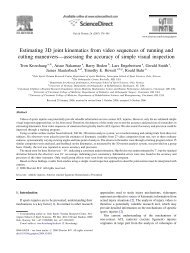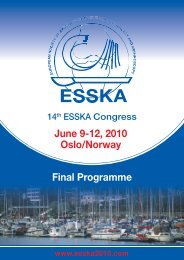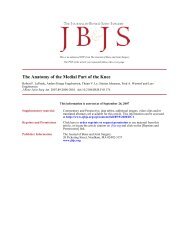ECSS Position Statement 2009: Prevention of acute sports injuries
ECSS Position Statement 2009: Prevention of acute sports injuries
ECSS Position Statement 2009: Prevention of acute sports injuries
You also want an ePaper? Increase the reach of your titles
YUMPU automatically turns print PDFs into web optimized ePapers that Google loves.
European Journal <strong>of</strong> Sport Science, July 2010; 10(4): 223236<br />
POSITION STATEMENT<br />
<strong>ECSS</strong> <strong>Position</strong> <strong>Statement</strong> <strong>2009</strong>: <strong>Prevention</strong> <strong>of</strong> <strong>acute</strong> <strong>sports</strong> <strong>injuries</strong><br />
KATHRIN STEFFEN 1 , THOR EINAR ANDERSEN 1 , TRON KROSSHAUG 1 ,<br />
WILLEM VAN MECHELEN 2 , GRETHE MYKLEBUST 1 , EVERT A. VERHAGEN 2 ,&<br />
ROALD BAHR 1<br />
1 Department <strong>of</strong> Sports Medicine, Oslo Sports Trauma Research Center, Norwegian School <strong>of</strong> Sport Sciences, Oslo, Norway,<br />
2 Research Centre for Physical Activity, VU Medical Centre, Amsterdam, Netherlands, and EMGO Institute, VU Medical<br />
Centre, Amsterdam, Netherlands<br />
Downloaded By: [Steffen, Kathrin] At: 02:55 10 June 2010<br />
Abstract<br />
To maximize the health benefits <strong>of</strong> <strong>sports</strong> and exercise and to minimize the direct and indirect costs associated with <strong>injuries</strong>,<br />
developing and adopting injury prevention strategies is an important goal. The aim <strong>of</strong> this <strong>ECSS</strong> consensus paper on injury<br />
prevention is to review current evidence on injury prevention methods and training programmes aimed at reducing the most<br />
common or severe types <strong>of</strong> <strong>acute</strong> <strong>injuries</strong>. The target audience is everyone involved in protecting the health <strong>of</strong> the athlete,<br />
including coaches, referees, medical staff, <strong>sports</strong> governing bodies, as well as athletes themselves. Effective <strong>sports</strong> injury<br />
prevention requires successful implementation <strong>of</strong> efficacious interventions. This paper reviews the main mechanisms and<br />
risk factors for <strong>acute</strong> <strong>injuries</strong> to the head, shoulder, elbow, hand/wrist, groin, thigh, knee, and ankle, as well as the evidence<br />
supporting various strategies to prevent them. Approaches that have been shown to be successful include: (1) using<br />
equipment designed to reduce injury risk, (2) adopting the rules <strong>of</strong> play, and (3) specific exercise programmes developed to<br />
reduce injury risk. Sports organizations should adopt available injury prevention strategies as part <strong>of</strong> their policies.<br />
Keywords: Athletic injury, prevention, risk factors, injury mechanisms, safety equipment, exercise programmes, health policy<br />
Introduction<br />
The physical activity guidelines <strong>of</strong> the American<br />
College <strong>of</strong> Sports Medicine recommend adults<br />
achieve 2030 min <strong>of</strong> vigorous exercise at least<br />
5 days a week for optimum functional capacity and<br />
health (Haskell et al., 2007). Numerous health<br />
benefits <strong>of</strong> physical activity have been well documented,<br />
resulting in public health support for<br />
regular physical activity and exercise. Regular physical<br />
activity reduces the risk <strong>of</strong> premature mortality<br />
in general, and <strong>of</strong> coronary heart disease, hypertension,<br />
colon cancer, obesity, and diabetes mellitus in<br />
particular (Haskell et al., 2007; LaMonte, Blair, &<br />
Church, 2005).<br />
The question is whether these health benefits<br />
outweigh the risk <strong>of</strong> potential injury and long-term<br />
disability associated with <strong>sports</strong> participation, especially<br />
at the elite level (Engebretsen & Bahr, <strong>2009</strong>). A<br />
Finnish study <strong>of</strong> the incidence <strong>of</strong> chronic disease and<br />
life expectancy <strong>of</strong> former elite athletes revealed that<br />
the rate <strong>of</strong> hospitalization for heart disease, respiratory<br />
disease, and cancer was lower for former athletes<br />
than for a control group <strong>of</strong> non-athletes. However,<br />
former athletes were more likely to have been<br />
hospitalized for musculoskeletal disorders (Kujala<br />
et al., 1996), and a follow-up study showed that<br />
former team sport athletes had an increased risk <strong>of</strong><br />
knee osteoarthritis (Kettunen, Kujala, Kaprio,<br />
Koskenvuo, & Sarna, 2001). Thus, although evidence<br />
suggests that <strong>sports</strong> participation is beneficial<br />
from a public health perspective, <strong>injuries</strong> also have<br />
significant negative side-effects in both the short and<br />
long term.<br />
Some injury types are <strong>of</strong> particular concern, either<br />
because they can be severe, such as head and knee<br />
<strong>injuries</strong>, or common, such as ankle sprain or hamstring<br />
strain <strong>injuries</strong>. These represent a considerable<br />
problem for the athlete, the team and, given the<br />
Correspondence: K. Steffen, Department <strong>of</strong> Sports Medicine, Oslo Sports Trauma Research Center, Norwegian School <strong>of</strong> Sport Sciences,<br />
Ullevaal Stadion, Sognsveien 220, PO Box 4014, N-0806, Oslo, Norway. E-mail: kathrin.steffen@nih.no<br />
ISSN 1746-1391 print/ISSN 1536-7290 online # 2010 European College <strong>of</strong> Sport Science<br />
DOI: 10.1080/17461390903585173
Downloaded By: [Steffen, Kathrin] At: 02:55 10 June 2010<br />
224 K. Steffen et al.<br />
popularity <strong>of</strong> <strong>sports</strong>, for society at large. Thus, to<br />
maximize the health benefits <strong>of</strong> <strong>sports</strong> and exercise<br />
and to minimize the direct and indirect costs<br />
associated with injury, developing methods to prevent<br />
<strong>sports</strong> <strong>injuries</strong> is a necessary goal. However, it<br />
should be kept in mind that the risk <strong>of</strong> injury will, to<br />
a certain extent, always persist when participating<br />
in <strong>sports</strong>.<br />
To develop effective injury prevention strategies, it<br />
is critical to know the causes <strong>of</strong> <strong>injuries</strong>. As described<br />
by Meeuwisse and colleagues (Meeuwisse, Tyreman,<br />
Hagel, & Emery, 2007), one important goal is to<br />
map the intrinsic and extrinsic factors that put an<br />
athlete at risk <strong>of</strong> injury. In addition, a precise<br />
description <strong>of</strong> the inciting event the injury mechanism<br />
is necessary (Bahr & Krosshaug, 2005).<br />
The aim <strong>of</strong> this <strong>ECSS</strong> consensus paper on injury<br />
prevention is to review current evidence on injury<br />
prevention strategies and training programmes<br />
aimed at reducing the most common or severe types<br />
<strong>of</strong> <strong>acute</strong> <strong>injuries</strong>. To better understand the rationale<br />
<strong>of</strong> effective injury prevention measures, each section<br />
also briefly describes the most important injury<br />
characteristics, risk factors, and mechanisms. General<br />
recommendations on the implementation <strong>of</strong><br />
injury prevention strategies are presented in the final<br />
section <strong>of</strong> this paper.<br />
Methods<br />
Individuals with extensive experience in prevention<br />
research related to each <strong>of</strong> the body regions covered<br />
here were identified. Each <strong>of</strong> them was asked to write<br />
a section outlining the current status regarding the<br />
characteristics, risk factors, and mechanisms <strong>of</strong><br />
injury to a specific region/injury type, as well as<br />
methods to prevent the injury in question. We did<br />
not require them to do a formal search <strong>of</strong> the<br />
literature, although most did to supplement their<br />
own literature database. Their draft was circulated<br />
among the group members until a final version,<br />
which was acceptable to all members, was arrived at.<br />
Head<br />
Injury characteristics<br />
Head and neck <strong>injuries</strong> are common across many<br />
<strong>sports</strong>. Horse riding, ice hockey, skiing/snowboarding,<br />
soccer and other football codes (e.g. American<br />
and Australian football) are <strong>sports</strong> where head<br />
<strong>injuries</strong> can result from a fall or from direct contact<br />
with <strong>sports</strong> equipment or other athletes, either<br />
by chance or through poor individual skills or<br />
rule violations. Recent reviews (Ackery, Hagel,<br />
Provvidenza, & Tator, 2007; Hagel, 2005) clearly<br />
show that a head injury is the most frequent reason<br />
for hospital admission and the most common<br />
cause <strong>of</strong> death among skiers and snowboarders.<br />
Fortunately, serious head <strong>injuries</strong> are rare. The<br />
majority (90%) <strong>of</strong> head <strong>injuries</strong> are minor, defined<br />
as mild concussions (Straume-Næsheim, Andersen,<br />
Dvorak, & Bahr, 2005). Concussions typically result<br />
in rapid but short-lived impairment <strong>of</strong> neurological<br />
function that resolves spontaneously. Although most<br />
athletes with head <strong>injuries</strong> recover uneventfully<br />
following a single concussive episode, repetitive<br />
mild head trauma may cause cognitive impairment<br />
(Kirkendall, Jordan, & Garrett, 2001; Straume-<br />
Næsheim et al., 2005). However, computerized<br />
neuropsychological testing did not reveal any impairment<br />
from heading exposure or previous concussions<br />
in a cohort <strong>of</strong> pr<strong>of</strong>essional soccer players<br />
(Straume-Næsheim et al., 2005).<br />
Risk factors<br />
Several risk factors for concussive <strong>injuries</strong> have been<br />
suggested. There is agreement in the skiing and<br />
snowboarding literature that beginners have an<br />
increased injury risk in general and a higher risk<br />
for head <strong>injuries</strong> in particular (Ackery et al., 2007;<br />
Hagel, 2005). In snowboarding, for instance, beginners<br />
tend to lose their balance more easily, which can<br />
result in a backwards fall with an impact to the back<br />
<strong>of</strong> the head. Snow parks with half pipes, rails, and<br />
other slope modifications are popular and may<br />
contribute to an increased risk <strong>of</strong> head injury as<br />
individual ability is <strong>of</strong>ten overestimated (Ackery<br />
et al., 2007; Hagel, 2005). The risk factors for<br />
catastrophic head and neck <strong>injuries</strong> are not known.<br />
Mechanisms<br />
Head <strong>injuries</strong> in <strong>sports</strong> arise mainly due to impacts<br />
with an opposing player, the ground/surface or<br />
equipment. In soccer, a blow <strong>of</strong> the elbow or arm<br />
to the opponent’s head, as well as a head-to-head<br />
contact are the main mechanisms for concussions<br />
(Andersen, Árnason, Engebretsen, & Bahr, 2004a;<br />
Fuller, Junge, & Dvorak, 2005). In skiing/snowboarding,<br />
concussions mainly result from a fall or<br />
landing that results in head contact with the ground,<br />
while even more severe head <strong>injuries</strong> may follow<br />
from collisions with other skiers or objects, such as<br />
trees, rocks or lift towers (Hagel, 2005).<br />
<strong>Prevention</strong><br />
Two main approaches have been used to prevent<br />
head <strong>injuries</strong>: using a helmet and rule modifications.
Downloaded By: [Steffen, Kathrin] At: 02:55 10 June 2010<br />
Helmets or padded headgear are used in<br />
many high-energy and collision <strong>sports</strong> to prevent<br />
head injury. A meta-analysis, based on five wellconducted<br />
case-control studies on pedal cycle helmets<br />
in transport and recreation, have confirmed<br />
that helmets provide a 6388% reduction in the risk<br />
<strong>of</strong> head, brain, and severe brain injury for cyclists <strong>of</strong><br />
all ages (Thompson, Rivara, & Thompson, 2000). In<br />
recreational skiing and snowboarding, there is solid<br />
evidence to show that using a helmet is associated<br />
with a 2260% reduction in head injury rates (Hagel,<br />
2005; Macnab, Smith, Gagnon, & Macnab, 2002;<br />
Sulheim, Holme, Ekeland, & Bahr, 2006). Thus, it is<br />
strongly recommended that recreational skiers and<br />
snowboarders wear helmets. There are no data from<br />
competitive cycling, skiing or snowboarding, but<br />
helmets are compulsory according to competition<br />
regulations for these and several other <strong>sports</strong>.<br />
Protective equestrian helmets are also widely recommended.<br />
Interestingly, since helmets were made<br />
compulsory for pr<strong>of</strong>essional jockeys in 199394, no<br />
significant improvements in concussion rates have<br />
been observed (McCrory & Turner, 2005). Research<br />
on padded headgear (s<strong>of</strong>t shell helmets) indicates<br />
that they do not reduce the incidence <strong>of</strong> concussion<br />
or serious head injury in rugby union football<br />
(McIntosh et al., <strong>2009</strong>), and similarly, data from<br />
soccer (Andersen et al., 2004a) and Australian rules<br />
football (McIntosh & McCrory, 2005) suggest that<br />
currently available head gear is unlikely to reduce the<br />
incidence <strong>of</strong> concussion.<br />
Rule modifications represent one strategy to reduce<br />
the risk <strong>of</strong> collisions and head impacts in <strong>sports</strong>, albeit<br />
direct scientific evidence is lacking. Studies from elite<br />
soccer show that approximately 40% <strong>of</strong> all concussions<br />
can be attributed to elbow and arm impacts in<br />
heading duels (Andersen et al., 2004a; Fuller et al.,<br />
2005). As a result, FIFA introduced a stricter rule<br />
before the 2006 World Cup, making contact to an<br />
opponent’s head with the elbow/upper arm during<br />
heading duels a ‘‘red card’’ <strong>of</strong>fence. In ice hockey,<br />
injury prevention programmes are becoming effective<br />
in reducing the number <strong>of</strong> <strong>injuries</strong>, especially head,<br />
cervical spine, and spinal cord <strong>injuries</strong> when banning<br />
checking from behind (McIntosh & McCrory, 2005).<br />
Shoulder<br />
Injury characteristics<br />
Acute shoulder <strong>injuries</strong> are common in <strong>sports</strong> that<br />
involve powerful and intentional body contact,<br />
including some <strong>of</strong> the football codes and ice hockey,<br />
but they are also common in <strong>sports</strong> that are<br />
characterized by high-energy falls on the shoulder,<br />
<strong>Prevention</strong> <strong>of</strong> <strong>acute</strong> <strong>sports</strong> <strong>injuries</strong> 225<br />
such as in skiing, snowboarding, ice skating, and<br />
cycling.<br />
The severity <strong>of</strong> an <strong>acute</strong> shoulder injury depends<br />
on the direction <strong>of</strong> the forces and the anatomical<br />
structure affected. Most <strong>acute</strong> shoulder <strong>injuries</strong> are<br />
minor, resulting in s<strong>of</strong>t tissue contusions around the<br />
shoulder. More severe trauma may result in a<br />
shoulder dislocation, clavicle fracture, acromioclavicular<br />
or sternoclavicular joint dislocation, or a<br />
fracture <strong>of</strong> the upper humerus (Krogsgaard, Safran,<br />
Rheinlænder, & Cheung, <strong>2009</strong>).<br />
Risk factors<br />
There is no evidence available on risk factors<br />
associated with <strong>acute</strong> shoulder <strong>injuries</strong>.<br />
Mechanisms<br />
An <strong>acute</strong> shoulder injury occurs either directly as a<br />
result <strong>of</strong> a fall or blow to the shoulder, or indirectly<br />
by transmission <strong>of</strong> forces through the arm.<br />
<strong>Prevention</strong><br />
There are no reports in the literature <strong>of</strong> methods to<br />
protect an athlete from an <strong>acute</strong> shoulder injury.<br />
However, any measures to reduce the risk <strong>of</strong> falls in<br />
<strong>sports</strong> should reduce the risk <strong>of</strong> shoulder injury.<br />
Shoulder pads can theoretically spread the forces<br />
from an impact over a larger area <strong>of</strong> the body and<br />
absorb energy, just like a helmet. In American football,<br />
shoulder pads protect the shoulder by dissipating<br />
the forces. No study, however, has proved the effect <strong>of</strong><br />
shoulder pads on reducing the risk <strong>of</strong> shoulder injury.<br />
In addition, hard shoulder pads have the disadvantage<br />
that they can hurt other players, particularly if they are<br />
used to butt other players (Krogsgaard et al., <strong>2009</strong>).<br />
Proper falling techniques can help potentially to<br />
lessen the direct impact placed across the shoulder<br />
joint by learning to roll when landing from a fall,<br />
rather than landing directly on the shoulder. Headfirst<br />
and diveback sliding techniques in baseball and<br />
s<strong>of</strong>tball can result in upper extremity <strong>injuries</strong>. However,<br />
changing techniques (e.g. banning sliding or<br />
forbidding head-first/diveback sliding) is impractical<br />
and unsatisfactory to players, and instructional<br />
courses regarding injury prevention have proved<br />
ineffective since players did not attend (Janda,<br />
2003). Even if direct evidence from team handball is<br />
lacking, the adoption <strong>of</strong> strict penalties for tackling<br />
the attacker’s arm from behind and holding the<br />
player’s arm when shooting is thought to prevent<br />
<strong>acute</strong> lesions to the shoulder joint. In summary, there<br />
is limited information on the risk factors for, or
Downloaded By: [Steffen, Kathrin] At: 02:55 10 June 2010<br />
226 K. Steffen et al.<br />
mechanisms, <strong>of</strong> <strong>acute</strong> shoulder <strong>injuries</strong>, and hence for<br />
effective prevention strategies.<br />
Elbow<br />
Injury characteristics<br />
Acute elbow <strong>injuries</strong> are most common in (1)<br />
contact and collision <strong>sports</strong> (e.g. American football,<br />
rugby, and martial arts), (2) <strong>sports</strong> that place an<br />
athlete at elevated heights (e.g. high jump, ski<br />
jumping, and gymnastics), and (3) high-speed <strong>sports</strong><br />
(e.g. alpine skiing, speed skating, and cycling). Also<br />
<strong>sports</strong> such as weightlifting, boxing, shot put, and<br />
javelin place <strong>acute</strong> and heavy loads across the elbow<br />
joint during training and competition and expose the<br />
elbow to a potential injury risk. Athletes who fall on<br />
an extended elbow with the hand in full supination<br />
can suffer a number <strong>of</strong> injury types, including bone<br />
bruises, ligament strains, muscle contusions, and<br />
skin abrasions, and in the worst cases fractures and<br />
dislocations, and even injury to neurovascular structures<br />
(Hutchinson & Andrews, <strong>2009</strong>).<br />
Risk factors<br />
There is no evidence available on risk factors<br />
associated with <strong>acute</strong> elbow <strong>injuries</strong>.<br />
Mechanisms<br />
An <strong>acute</strong> elbow injury can occur via a direct impact<br />
to the elbow (e.g. by a fall or a collision) or by an<br />
indirect impact resulting in torques across the elbow,<br />
such as falling on an outstretched hand the classical<br />
injury description. When the elbow is hyperextended<br />
and when moments and forces are excessive, the<br />
collateral ligaments will rupture and damage the<br />
anterior capsule. If the forces continue, the elbow<br />
will dislocate. In judo, for instance, an athlete is<br />
allowed to place the opponent’s elbow in an elbow<br />
lock, a position <strong>of</strong> hyperextension. Indeed, if the<br />
athlete on the receiving end <strong>of</strong> this manoeuvre does<br />
not ‘‘tap-out’’ to concede defeat, continued force<br />
may lead to an elbow dislocation (Hutchinson &<br />
Andrews, <strong>2009</strong>).<br />
<strong>Prevention</strong><br />
There has been limited research on injury prevention<br />
methods, although it has been suggested that elbow<br />
<strong>injuries</strong> may be prevented through protective padding<br />
and education <strong>of</strong> athletes on how to fall<br />
properly (Hutchinson & Andrews, <strong>2009</strong>). Minimizing<br />
risk exposures and energy transfer during falls<br />
could be accomplished via rule enforcement, more<br />
severe penalties for violations, or rule changes. An<br />
example that has been shown to be effective was<br />
limiting the height <strong>of</strong> cheerleader towers, which, in<br />
turn, reduced the potential energy and risk <strong>of</strong> injury<br />
from falls (Boden, Tacchetti, & Mueller, 2003). In<br />
judo, banning the ability <strong>of</strong> a competitor to hyperextend<br />
the elbow and subsequently dislocate it until<br />
his opponent taps out (gives up) would likely reduce<br />
the risk <strong>of</strong> elbow <strong>injuries</strong> in judo (Hutchinson &<br />
Andrews, <strong>2009</strong>). Unfortunately, similar to traumatic<br />
shoulder <strong>injuries</strong>, there is limited evidence on how to<br />
prevent <strong>acute</strong> shoulder <strong>injuries</strong>. However, as for<br />
<strong>acute</strong> shoulder <strong>injuries</strong>, many <strong>acute</strong> elbow <strong>injuries</strong><br />
are simply accidents that occur during the routine<br />
performance <strong>of</strong> a high-risk sport.<br />
Hand/wrist<br />
Injury characteristics<br />
Sprains <strong>of</strong> finger and wrist joints as well as fractures<br />
<strong>of</strong> the wrist and fingers are typical in ball <strong>sports</strong> and<br />
other <strong>sports</strong> involving falling activities/accidents.<br />
Wrist fractures are common in snowboard <strong>sports</strong><br />
(Hagel, 2005; Langran and Selvaraj, 2004). Wrist<br />
<strong>injuries</strong> account for 8% <strong>of</strong> <strong>injuries</strong> among elite<br />
snowboarders (Torjussen & Bahr, 2005, 2006), and<br />
up to 32% among recreational boarders (Langran &<br />
Selvaraj, 2004; Machold et al., 2002). In less serious<br />
cases, falls result in sprains <strong>of</strong> the wrist joint (Hagel,<br />
2005). ‘‘Skier’s thumb’’ is a tear <strong>of</strong> the ulnar<br />
collateral ligament <strong>of</strong> the first metacarpophalangeal<br />
joint, leading to instability <strong>of</strong> the joint (Mogan &<br />
Davis, 1982), while volleyball players can tear<br />
the radial collateral ligament <strong>of</strong> the same joint<br />
when playing defence (‘‘volleyball thumb’’) (Bahr&<br />
Reeser, 2003). Most other finger <strong>injuries</strong> in, for<br />
example, volleyball and team handball are mild ligament<br />
<strong>injuries</strong> with which the athlete continues to train<br />
or compete, with or without exposed fingers taped.<br />
Risk factors<br />
Finger sprains take time to heal, and a history <strong>of</strong> a<br />
previous finger sprain exposes this finger to new<br />
<strong>injuries</strong>. Novice snowboarders are 23 times more<br />
likely to injure their wrist than experienced boarders<br />
(Goulet, Hagel, Hamel, & Légaré, <strong>2009</strong>; Langran &<br />
Selvaraj, 2004; Machold et al., 2002). Snow parks<br />
with half pipes, rails and jumps contribute to an<br />
increased risk <strong>of</strong> wrist sprains and fractures as a<br />
result <strong>of</strong> poor or overestimated physical and technical<br />
ability (Hagel, 2005).<br />
Mechanisms<br />
Complicated fractures <strong>of</strong> the wrist or forearm may<br />
occur as a result <strong>of</strong> a direct fall or <strong>of</strong> an unsuccessful
Downloaded By: [Steffen, Kathrin] At: 02:55 10 June 2010<br />
jump, typically seen in skiers and snowboarders.<br />
When balance is lost, snowboarders, unlike skiers,<br />
cannot ‘‘step out’’ a leg to recover the lost balance,<br />
as both feet are firmly attached to the board. The<br />
instinctive protective reaction is to reach out to break<br />
the landing, thus placing the wrist and fingers at risk<br />
<strong>of</strong> injury (Machold et al., 2002). The typical<br />
mechanism for skier’s thumb is when a skier falls<br />
with the ski pole left in the hand forcing the thumb<br />
into adduction and extension (Browne, Dunn, &<br />
Snyder, 1976). The mechanism <strong>of</strong> finger sprains in<br />
volleyball and team handball is similar: hyperextension<br />
when the ball unexpectedly hits the finger<br />
during defence or blocking.<br />
<strong>Prevention</strong><br />
There is agreement in the literature that most wrist<br />
fractures in snowboarding can be prevented by use <strong>of</strong><br />
wrist protectors, at least among beginners (Rønning,<br />
Rønning, Gerner, & Engebretsen, 2001; Russell,<br />
Hagel, & Francescutti, 2007). Wrist protectors are,<br />
beside helmet use, one <strong>of</strong> the simplest strategies to<br />
prevent <strong>injuries</strong> in snowboarding. For every 50<br />
snowboarders who wear a wrist guard, one wrist<br />
injury will be averted (Russell et al., 2007). However,<br />
the optimal type <strong>of</strong> wrist guard to most<br />
effectively prevent wrist <strong>injuries</strong> has not been identified.<br />
There is no conclusive evidence whether or not<br />
wrist guards increase the risk <strong>of</strong> shoulder, shoulder<br />
girdle or elbow <strong>injuries</strong> (Hagel, 2005; Russell et al.,<br />
2007). For skiers, strapless poles have not been<br />
shown to decrease the incidence <strong>of</strong> skier’s thumb.<br />
However, if skiers are trained to discard the pole<br />
during a fall, the risk <strong>of</strong> injury might be reduced<br />
(Fricker & Hintermann, 1995).<br />
One obvious way to try and reduce the risk <strong>of</strong><br />
<strong>injuries</strong> to the upper limb in general and the wrist<br />
joint in particular is to adopt the correct falling<br />
techniques and avoid landing on an outstretched<br />
hand. Finger sprains among team sport players may<br />
be prevented by prophylactic taping <strong>of</strong> the exposed<br />
fingers, especially fingers with previous ligamentous<br />
<strong>injuries</strong>.<br />
Groin<br />
Injury characteristics<br />
The pelvis is the centre <strong>of</strong> load transfer from the<br />
upper extremities and the torso to the lower extremities<br />
and vice versa, and a number <strong>of</strong> muscle<br />
groups interact to stabilize the region and facilitate<br />
energy transfer around the pelvic and hip region,<br />
including the adductors, iliopsoas, abdominal, and<br />
erector spinae muscles. Groin <strong>injuries</strong> are among the<br />
top six most cited <strong>injuries</strong> in soccer, rugby, American<br />
<strong>Prevention</strong> <strong>of</strong> <strong>acute</strong> <strong>sports</strong> <strong>injuries</strong> 227<br />
football, ice hockey, speed skating, swimming, and<br />
athletics, accounting for more than 10% <strong>of</strong> all<br />
<strong>injuries</strong> and 2040% <strong>of</strong> all muscle strain <strong>injuries</strong><br />
(Maffey & Emery, 2007). A strain to the groin<br />
muscles may be <strong>acute</strong> but <strong>of</strong>ten becomes chronic<br />
in nature. Suffering from persistent groin <strong>injuries</strong><br />
results in extensive rehabilitation and longstanding<br />
pain (Jansen, Mens, Backx, Kolfschoten, & Stam,<br />
2008; Macintyre, Johson, & Schroeder, 2006); as an<br />
example, 40% <strong>of</strong> groin <strong>injuries</strong> in soccer result in<br />
more than one week out, and 10% in more than one<br />
month out (Maffey & Emery, 2007).<br />
Risk factors<br />
There is clear evidence that a previous strain <strong>of</strong><br />
the groin muscles on the same side is a strong<br />
predictor for a recurrent injury (Emery, Meeuwisse,<br />
& Hartmann, 2005; Hägglund, Waldén, & Ekstrand,<br />
2006; Steffen, Myklebust, Andersen, Holme, &<br />
Bahr, 2008a). This may be due to scar tissue<br />
formation in the muscle or tendon or inadequately<br />
rehabilitated strength or flexibility (Árnason et al.,<br />
2004; Emery et al., 2005; Steffen et al., 2008a).<br />
Other intrinsic risk factors believed to be involved in<br />
groin <strong>injuries</strong> are reduced adductor strength and<br />
flexibility <strong>of</strong> the hip abductors (Árnason et al., 2004;<br />
Maffey & Emery, 2007; Verrall et al., 2005).<br />
Decreased adductor muscle strength and an imbalanced<br />
adductor-to-abductor muscle strength ratio<br />
have been shown to predict groin strain <strong>injuries</strong>. Ice<br />
hockey players were 17 times more likely to sustain<br />
an adductor muscle strain if adductor strength was<br />
less than 80% <strong>of</strong> abductor strength (Tyler, Nicholas,<br />
Campbell, & McHugh, 2001). Reduced flexibility <strong>of</strong><br />
the abductor and adductor muscles has been suggested<br />
as a risk factor for groin strain <strong>injuries</strong><br />
(Árnason et al., 2004; Ekstrand & Gillquist, 1983;<br />
Verrall et al., 2005). However, the evidence is<br />
conflicting (Maffey & Emery, 2007), as it is for age<br />
and <strong>sports</strong> exposure as risk factors for groin <strong>injuries</strong><br />
(Árnason et al., 2004; Maffey & Emery, 2007).<br />
Mechanisms<br />
As groin <strong>injuries</strong> <strong>of</strong>ten show a transition into an<br />
overuse condition, the exact moment <strong>of</strong> injury and<br />
the injury mechanisms are hard to establish. Athletes<br />
who develop groin problems are <strong>of</strong>ten engaged in<br />
<strong>sports</strong> involving kicking, rapid changes <strong>of</strong> direction,<br />
accelerations and decelerations (Macintyre et al.,<br />
2006). The adductor muscles may be <strong>acute</strong>ly<br />
strained during an eccentric contraction (e.g. in a<br />
forced abduction), most likely when the limb is in<br />
abduction. This could be a sudden resistance caused<br />
by an opponent’s foot in an attempt to reach a ball or<br />
a sliding tackle in soccer, or the eccentric force <strong>of</strong> the
Downloaded By: [Steffen, Kathrin] At: 02:55 10 June 2010<br />
228 K. Steffen et al.<br />
adductor muscles attempting to decelerate the leg<br />
during a stride in ice hockey. The adductor muscles<br />
can also be strained in a forceful concentric contraction,<br />
as during a kick after a ball in the air. The<br />
iliopsoas muscle can be <strong>acute</strong>ly strained if a forceful<br />
hip flexion is interrupted suddenly, as if tackled or<br />
hitting the ground when kicking, but also during an<br />
eccentric contraction (Árnason et al., 2004; Maffey<br />
& Emery, 2007; Meeuwisse et al., 2007).<br />
<strong>Prevention</strong><br />
A previous groin injury is the best established risk<br />
factor, emphasizing the need for adequate rehabilitation<br />
<strong>of</strong> the primary groin injury before returning to<br />
<strong>sports</strong> (Árnason et al., 2004; Hägglund et al., 2006;<br />
Steffen et al., 2008a). It is unclear whether stretching<br />
<strong>of</strong> the adductor/abductor and iliopsoas muscles can<br />
prevent groin <strong>injuries</strong>. However, a functional flexibility<br />
<strong>of</strong> these muscles and range <strong>of</strong> motion <strong>of</strong> the hip<br />
joint may be important (Árnason et al., 2004).<br />
As many groin <strong>injuries</strong> occur during eccentric<br />
loading, reduced eccentric strength <strong>of</strong> the adductor<br />
muscles has been suggested as a possible risk factor.<br />
However, studies on different athlete populations<br />
(ice hockey, soccer) do not provide conclusive<br />
evidence for general strengthening exercises as a<br />
prevention method (Maffey & Emery, 2007). Nevertheless,<br />
an intervention study including specific<br />
strength training <strong>of</strong> the adductor muscles (static,<br />
concentric, and eccentric), as well as core stability<br />
exercises for the pelvic muscles showed a highly<br />
significant effect in the treatment <strong>of</strong> adductor-related<br />
groin <strong>injuries</strong> (Hölmich et al., 1999). However, this<br />
programme has not been evaluated as a primary<br />
prevention method, although such exercises are<br />
commonly included in general prevention programmes<br />
for lower extremity <strong>injuries</strong>.<br />
Thigh<br />
Injury characteristics<br />
Common thigh <strong>injuries</strong> are contusions to the anterior<br />
and lateral thigh and strains to the quadriceps or<br />
hamstring muscles. A hamstring strain is the most<br />
common type <strong>of</strong> injury in many <strong>sports</strong>, particularly in<br />
the football codes, which are characterized by sudden<br />
accelerations and decelerations, <strong>of</strong>ten followed by<br />
changes <strong>of</strong> direction, and eccentric muscle activity<br />
during sprinting and kicking (Árnason et al., 2004;<br />
Askling, Tengvar, Saartok, & Thorstensson, 2008;<br />
Hägglund et al., 2006; Mjølsnes, Árnason, Østhagen,<br />
Raastad, & Bahr, 2004). Recent studies suggest that<br />
the proportion <strong>of</strong> hamstring strains has increased in<br />
soccer during the past decade, as the sport has become<br />
more physically demanding with more frequent and<br />
higher intensity runs (Árnason et al., 2004; Hägglund<br />
et al., 2006). Sports characterized by slow stretching<br />
beyond the usual movement <strong>of</strong> the muscles, in<br />
particular hip flexion (e.g. dancing), also have high<br />
rates <strong>of</strong> hamstring <strong>injuries</strong> (Askling et al., 2008).<br />
Risk factors<br />
The two factors most consistently associated with a<br />
hamstring strain injury are a history <strong>of</strong> previous<br />
injury and age (older players with higher risk)<br />
(Árnason et al., 2004). Some studies indicate that<br />
decreased hamstring strength (concentric and eccentric),<br />
low hamstring-to-quadriceps strength ratio,<br />
and a side-to-side difference in hamstring strength<br />
could be risk factors for hamstring strains (Murphy,<br />
Connolly, & Beynnon, 2003). Poor flexibility <strong>of</strong> the<br />
hamstring muscles has also been suggested as a risk<br />
factor for muscular strains (Murphy et al., 2003).<br />
However, there is a paucity <strong>of</strong> evidence, and the<br />
methodology has been poor, thereby not allowing<br />
definitive conclusions to be drawn.<br />
Mechanisms<br />
Most hamstring strains occur during maximal sprinting<br />
activities in the late swing phase, when the<br />
hamstring muscles are loaded eccentrically to decelerate<br />
the forward movement <strong>of</strong> the leg, or at<br />
foot-strike, in the transition from eccentric to concentric<br />
muscle action (Árnason,Andersen,Holme,<br />
Engebretsen, & Bahr, 2008; Askling et al., 2008;<br />
Proske, Morgan, Brockett, & Percival, 2004). It has<br />
therefore been postulated that eccentric overload could<br />
cause tearing in the muscle tendon unit (Árnason et al.,<br />
2004; Garrett, 1990; Maffey & Emery, 2007).<br />
<strong>Prevention</strong><br />
Based on the injury mechanism, it has been suggested<br />
that eccentric strength is important to prevent hamstring<br />
strains. There is good evidence that eccentric<br />
strength training <strong>of</strong> the hamstring muscles increases<br />
hamstring muscle torque more effectively than concentric<br />
hamstrings training (Askling, Karlsson, &<br />
Thorstensson, 2003; Mjølsnes et al., 2004) and<br />
reduces the incidence <strong>of</strong> hamstring strains in elite<br />
male soccer players (Árnason et al., 2004; Askling<br />
et al., 2003; Mjølsnes et al., 2004). The Nordic<br />
hamstring lower exercise is a partner exercise in which<br />
the athlete attempts to resist a forward-falling motion<br />
<strong>of</strong> the upper body using the hamstring muscles to<br />
maximize loading in the eccentric phase. In a study on<br />
Norwegian and Icelandic male soccer players, this<br />
exercise reduced the risk <strong>of</strong> hamstring strains by 65%<br />
(Árnason et al., 2008). There is little or no evidence in<br />
the literature to suggest that flexibility training alone
Downloaded By: [Steffen, Kathrin] At: 02:55 10 June 2010<br />
can prevent hamstring strains in soccer or other <strong>sports</strong>.<br />
One explanation may be that most hamstring strains<br />
occur during maximal sprinting, when the hamstring<br />
muscles are not stretched towards their maximum<br />
range (Árnason et al., 2008; Askling et al., 2008; Verrall<br />
et al., 2005). Eccentric hamstring training using the<br />
Nordic hamstring exercise has been included in<br />
several general lower extremity injury prevention<br />
programmes targeting young athletes (Gilchrist<br />
et al., 2008; Mandelbaum et al., 2005; Olsen,<br />
Myklebust, Engebretsen, Holme, & Bahr, 2005;<br />
Soligard et al., 2008; Steffen, Myklebust, Olsen,<br />
Holme, & Bahr, 2008b).<br />
Knee<br />
Injury characteristics<br />
Typical <strong>injuries</strong> to the knee are ligament tears <strong>of</strong> the<br />
collateral or cruciate ligaments; these may be associated<br />
with meniscal tears, or cartilage and bone<br />
damage <strong>of</strong> varying severity (Griffin et al., 2006;<br />
Renström et al., 2008). Anterior cruciate ligament<br />
(ACL) <strong>injuries</strong> are common and serious, and are<br />
associated with an increased risk for early osteoarthritis.<br />
The majority <strong>of</strong> ACL-injured athletes will<br />
develop osteoarthritis within 1520 years, regardless<br />
<strong>of</strong> treatment (Lohmander, Östenberg, Englund, &<br />
Roos, 2004; Myklebust & Bahr, 2005; von Porat,<br />
Roos, & Roos, 2004). Athletes from pivoting <strong>sports</strong><br />
such as soccer and other football codes, team handball,<br />
and basketball are at risk <strong>of</strong> sustaining such<br />
<strong>injuries</strong> (Hootman, Dick, & Agel, 2007; Myklebust<br />
et al., 2003). Alpine skiing is another activity<br />
associated with high risk for knee and ACL <strong>injuries</strong><br />
(Pujol, Blanchi, & Chambat, 2007).<br />
Risk factors<br />
As for most other injury types, recent studies have<br />
suggested that a history <strong>of</strong> knee injury is a risk factor<br />
for a subsequent knee (Hägglund et al., 2006;<br />
Steffen et al., 2008a) or ACL injury (Faude, Junge,<br />
Kindermann, & Dvorak, 2006; Waldén, Hägglund,<br />
& Ekstrand, 2006). Female athletes are reported to<br />
have a three- to six-fold higher incidence <strong>of</strong> noncontact<br />
ACL <strong>injuries</strong> than their male counterparts<br />
(Hewett, Myer, & Ford, 2006b). However, the<br />
reasons for the gender gap are not clear. Various<br />
researchers have suggested differences in anatomy,<br />
as well as hormonal and neuromuscular function as<br />
potential reasons for the gender gap (for reviews,<br />
see Griffin et al., 2006; Renström et al., 2008;<br />
Shimokochi & Shultz, 2008). However, there are<br />
only a few well-designed prospective studies available,<br />
most <strong>of</strong> which assessed only one risk factor in<br />
isolation. ACL <strong>injuries</strong> can most likely not be<br />
<strong>Prevention</strong> <strong>of</strong> <strong>acute</strong> <strong>sports</strong> <strong>injuries</strong> 229<br />
attributed to one single factor and large-scale studies<br />
are needed to assess how different risk factors act in<br />
combination to put the female athlete at risk.<br />
Thus, there is a paucity <strong>of</strong> evidence linking all<br />
these potential risk factors to non-contact ACL<br />
<strong>injuries</strong>, and a great deal <strong>of</strong> controversy exists on<br />
the importance <strong>of</strong> the different intrinsic risk factors.<br />
From the available evidence, it appears that the<br />
predictive value <strong>of</strong> static anatomic properties such as<br />
knee alignment, Q-angle, knee geometry, and leg<br />
length is limited (for reviews, see Griffin et al., 2006;<br />
Renström et al., 2008; Shimokochi & Shultz, 2008).<br />
Differences in mechanical properties <strong>of</strong> the ACL<br />
may be another link to the association between ACL<br />
tensile properties and injury risk (Chandrashekar,<br />
Mansouri, Slauterbeck, & Hashemi, 2006).<br />
There is a consensus emerging from the literature<br />
that the likelihood <strong>of</strong> incurring an ACL injury does<br />
not remain constant during the menstrual cycle, with<br />
a significantly greater risk during the pre-ovulatory<br />
phase than during the post-ovulatory phase (Hewett,<br />
Zazulak, & Myer, 2007).<br />
Compared with anatomical and hormonal risk<br />
factors, neuromuscular risk factors are more easily<br />
addressed by prevention training. It has been shown<br />
that females exhibit greater quadriceps dominance,<br />
and have less muscle stiffness and muscle strength.<br />
However, none <strong>of</strong> these factors have been assessed in<br />
prospective ACL injury risk factor studies and,<br />
consequently, it is not possible to determine the<br />
relative importance <strong>of</strong> these factors. To date, only<br />
one study has documented a link between dynamic<br />
knee valgus motion and ACL injury risk (Hewett<br />
et al., 2005). However, the limited sample size (only<br />
9 ACL ruptures) means that the results <strong>of</strong> this study<br />
must be interpreted with caution. Deficits in neuromuscular<br />
control <strong>of</strong> the trunk have also been shown<br />
to be associated with knee injury risk (Zazulak,<br />
Hewett, Reeves, Goldberg, & Cholewicki, 2007).<br />
Investigations from Australian rules football<br />
(Orchard, 2002) and team handball (Olsen,<br />
Myklebust, Engebretsen, & Bahr, 2004) suggest<br />
that a high shoesurface friction is connected to an<br />
increased risk <strong>of</strong> ACL injury.<br />
Mechanisms<br />
ACL <strong>injuries</strong> are commonly non-contact in nature<br />
and can occur during plant and cut manoeuvres or<br />
during landings. Although most ACL <strong>injuries</strong> are<br />
non-contact by definition, the movement patterns<br />
<strong>of</strong>ten involve perturbation by an opponent, such as<br />
body contact prior to the injury (Krosshaug et al.,<br />
2007a). However, even if these few details are<br />
known, we still lack vital knowledge about the injury<br />
mechanisms. A complete biomechanical description<br />
should quantify whole-body and knee kinematics,
Downloaded By: [Steffen, Kathrin] At: 02:55 10 June 2010<br />
230 K. Steffen et al.<br />
loading directions, magnitudes, and rates (Krosshaug,<br />
Andersen, Olsen, Myklebust, & Bahr, 2005).<br />
The biomechanical mechanisms for non-contact<br />
ACL <strong>injuries</strong> are widely debated. The two most<br />
discussed theories involve the quadriceps drawer<br />
mechanism and valgus loading. Proponents <strong>of</strong> the<br />
first theory argue that ACL <strong>injuries</strong> result from<br />
loading in the sagittal plane only, primarily as a<br />
result <strong>of</strong> anterior shear forces caused by forceful<br />
quadriceps contraction when landing or cutting<br />
(Yu & Garrett, 2007). This mechanism was demonstrated<br />
in a cadaver study (DeMorat, Weinhold,<br />
Blackburn, Chudik, & Garrett, 2004), but was<br />
criticized for not taking ground reaction forces into<br />
consideration. Others argue that knee abduction<br />
must be involved in the injury mechanism (Quatman<br />
& Hewett, <strong>2009</strong>). This theory is partly based on<br />
video analyses <strong>of</strong> ACL-injured athletes where<br />
valgus or valgus collapse are frequently reported<br />
(Krosshaug et al., 2007a; Krosshaug, Slauterbeck,<br />
Engebretsen, & Bahr, 2007b; Olsen et al., 2004).<br />
The combination <strong>of</strong> external rotation and valgus can<br />
possibly result in femoral notch impingement (Fung<br />
& Zhang, 2003).<br />
Furthermore, anterior tibial translation induced<br />
by a high tibi<strong>of</strong>emoral compression and tibial plateau<br />
inclination has been proposed as a possible loading<br />
mechanism (Meyer & Haut, 2008). Internal rotation<br />
<strong>of</strong> the tibia on a relatively extended knee is suggested<br />
as an ACL injury mechanism by cadaver studies<br />
(Markolf et al., 1995), by athlete interview studies<br />
(Myklebust, Maehlum, Holm, & Bahr, 1998), and<br />
by video analysis (Olsen et al., 2004). However, to<br />
make conclusive statements on the mechanisms <strong>of</strong><br />
non-contact ACL <strong>injuries</strong>, new, sophisticated methods<br />
<strong>of</strong> video analysis (Krosshaug et al., 2007a)<br />
combined with other research approaches such as<br />
clinical studies and cadaver simulation or mathematical<br />
simulation studies are needed (Krosshaug et al.,<br />
2005).<br />
The mechanisms <strong>of</strong> knee <strong>injuries</strong> in alpine skiing<br />
and snowboarding are likely to be different from<br />
those in team <strong>sports</strong> and at least among recreational<br />
skiers. According to Ettlinger and colleagues<br />
(Ettlinger, Johnson, & Shealy, 1995), the two main<br />
mechanisms are the so-called ‘‘phantom foot’’ (i.e.<br />
internal rotation in deep flexion due to canting <strong>of</strong> the<br />
inside edge <strong>of</strong> the tail <strong>of</strong> the ski) and the ‘‘bootinduced<br />
anterior drawer mechanism’’.<br />
<strong>Prevention</strong><br />
Injury prevention programmes have been developed<br />
to reduce the risk <strong>of</strong> ligamentous knee <strong>injuries</strong> in<br />
general, and ACL <strong>injuries</strong> in particular (Hewett,<br />
Ford, & Myer, 2006a; Renström et al., 2008). They<br />
are generally based on the assumption that modifying<br />
the dynamic biomechanical risk factors can<br />
prevent <strong>injuries</strong>. Successful prevention programmes<br />
alter the dynamic loading <strong>of</strong> the knee joint through<br />
neuromuscular training. Based on the likely injury<br />
mechanisms, it is recommended that athletes avoid<br />
knee valgus and land with knee flexion to absorb<br />
landing forces (Hewett, 2006a; Krosshaug et al.,<br />
2007a; Renström et al., 2008). Training programmes<br />
that incorporate plyometrics aim to result<br />
in safe levels <strong>of</strong> valgus stress to the knee and<br />
alterations in neuromuscular control patterns<br />
(Hewett et al., 2006a). As shown in several welldesigned<br />
intervention studies from soccer and team<br />
handball, programmes incorporating one or more<br />
exercise components to modify dynamic control <strong>of</strong><br />
the lower limbs have resulted in remarkable reductions<br />
in the risk for ACL <strong>injuries</strong> (Gilchrist et al.,<br />
2008; Mandelbaum et al., 2005; Myklebust et al.,<br />
2003) or lower extremity <strong>injuries</strong> (Olsen et al., 2005;<br />
Soligard et al., 2008; Pasanen et al., 2008). Balance<br />
training alone, and all homed-based training without<br />
instruction and feedback on proper movement<br />
technique (lower limb alignment, two-feet landings),<br />
is probably not as effective as when it is combined<br />
with other types <strong>of</strong> neuromuscular exercise stimuli<br />
(Hewett et al., 2006a; Söderman, Werner, Pietila,<br />
Engström, & Alfredson, 2000).<br />
Evidence from research on alpine skiers shows that<br />
an educational programme to increase awareness <strong>of</strong><br />
and modify behaviour in high-risk situations can<br />
prevent ACL <strong>injuries</strong> (Ettlinger et al., 1995).<br />
Ankle<br />
Injury characteristics<br />
An <strong>acute</strong> lateral ligament injury to the ankle (ankle<br />
sprain) represents the dominant injury type in many<br />
<strong>sports</strong>. Most ankle sprains result in an absence from<br />
training and competition for not more than a week.<br />
Nevertheless, because they are so common in many<br />
<strong>sports</strong>, ankle sprains account for a substantial part <strong>of</strong><br />
the total injury load. In female youth soccer, for<br />
instance, up to 40% <strong>of</strong> all <strong>injuries</strong> are ankle sprains<br />
(Le Gall, Carling, & Reilly, 2008; Söderman,<br />
Adolphson, Lorentzon, & Alfredson, 2001; Steffen,<br />
Andersen, & Bahr, 2007), and in volleyball they<br />
account for up to 50% <strong>of</strong> all reported <strong>injuries</strong> (Bahr<br />
& Bahr, 1997; Verhagen et al., 2004). From a public<br />
health perspective, ankle sprains therefore constitute<br />
a large part <strong>of</strong> the medical costs due to <strong>sports</strong> <strong>injuries</strong><br />
(Verhagen, van Tulder, van der Beek, Bouter, & van<br />
Mechelen, 2005).
Downloaded By: [Steffen, Kathrin] At: 02:55 10 June 2010<br />
Risk factors<br />
The only well-documented and probably by far<br />
strongest risk factor for an ankle sprain is a previous<br />
sprain sustained in the previous 12 months. Studies<br />
on various athlete groups found a two- to five-fold<br />
increased risk for a lateral ankle ligament injury after<br />
suffering a prior ankle injury (Árnason et al., 2004;<br />
Steffen et al., 2008a; Verhagen et al., 2004). There is<br />
strong evidence that an ankle sprain negatively affects<br />
neuromuscular control, believed to be due to trauma<br />
to mechanoreceptors <strong>of</strong> the ankle ligaments causing<br />
proprioceptive impairment (Freeman, 1965). As a<br />
result, a previously injured ankle is exposed to an<br />
increased risk <strong>of</strong> re-injury (Árnason et al., 2004;<br />
Steffen et al., 2008a; Verhagen et al., 2004). There<br />
is conflicting evidence about the injury impact <strong>of</strong><br />
other intrinsic risk factors, such as ankle joint laxity or<br />
decreased dorsiflexion <strong>of</strong> the ankle (Árnason et al.,<br />
2004). Anatomic foot type, when classified as pronated,<br />
supinated or neutral, does not appear to be a<br />
risk factor for ankle sprains.<br />
Mechanisms<br />
Common mechanisms <strong>of</strong> ankle sprains are tackling,<br />
running or landing on uneven ground or the foot <strong>of</strong><br />
another player. Two specific injury mechanisms are<br />
reported in soccer: (1) player-to-player contact with<br />
impact by an opponent on the medial aspect <strong>of</strong> the<br />
leg just before or at foot strike, resulting in a laterally<br />
directed force causing the player to land with the<br />
ankle in a vulnerable position; and (2) forced plantar<br />
flexion where the injured player hits the opponent’s<br />
foot when attempting to shoot or clear the ball<br />
(Andersen, Flørenes, Árnason, & Bahr, 2004b; Giza,<br />
Fuller, Junge, & Dvorak, 2003). In volleyball, ankle<br />
sprains typically occur at the net, resulting from<br />
contact between the blocker and the opposing<br />
attacker across the centreline or when a blocker<br />
lands on a team-mate’s foot when participating in a<br />
multi-person block (Bahr & Bahr, 1997; Verhagen<br />
et al., 2004).<br />
<strong>Prevention</strong><br />
Athletes with a history <strong>of</strong> ankle sprains should be<br />
targeted, especially those who sustained such an<br />
injury during the preceding 12 months. Ankle<br />
proprioception is critical to keep the ankle in a safe<br />
‘‘neutral’’ position, and this ability is <strong>of</strong>ten impaired<br />
after injury. External support (bracing, taping)<br />
has been shown to reduce the risk <strong>of</strong> re-injury in<br />
athletes with a history <strong>of</strong> ankle sprains, but not in<br />
athletes with no previous history (Surve, Schwellnus,<br />
Noakes, & Lombard, 1994; Tropp, Askling, &<br />
<strong>Prevention</strong> <strong>of</strong> <strong>acute</strong> <strong>sports</strong> <strong>injuries</strong> 231<br />
Gillquist, 1985). A cheaper, well-investigated and<br />
highly effective prophylactic measure is balance<br />
training. Such neuromuscular training is thought to<br />
improve proprioception by re-establishing and<br />
strengthening the protective reflexes <strong>of</strong> the ankle<br />
(Verhagen et al., 2004). Exercises on balance boards<br />
or mats have been shown to reduce the risk <strong>of</strong><br />
ankle sprains by as much as 50% (Emery, Rose,<br />
McAllister, & Meeuwisse, 2007; Olsen et al., 2005;<br />
Verhagen et al., 2004). However, as for external<br />
ankle support, the effect appears to be limited only<br />
to athletes with a history <strong>of</strong> previous sprains. It is also<br />
important to note that specific technical training to<br />
avoid vulnerable situations may be effective, at least<br />
in volleyball (Bahr, Lian, & Bahr, 1997). In soccer,<br />
late tackles resulting in laterally directed blows to the<br />
lower leg serve to put the ankle in a vulnerable<br />
position when landing or running (Andersen et al.,<br />
2004b; Giza et al., 2003). More specific wording <strong>of</strong><br />
the rules <strong>of</strong> the game regarding late tackles, in<br />
particular two-footed tackles, with stricter penalties,<br />
may prevent ankle <strong>injuries</strong> (Andersen et al., 2004b;<br />
Giza et al., 2003).<br />
General conclusions<br />
In a review <strong>of</strong> the present literature, we found<br />
varying evidence on the prevention <strong>of</strong> <strong>acute</strong> <strong>sports</strong><br />
<strong>injuries</strong>. Although much research has been conducted<br />
to help reduce lower extremity injury risk,<br />
there is much less evidence on injury risk factors and<br />
mechanisms and, consequently, on the prevention <strong>of</strong><br />
<strong>acute</strong> upper extremity <strong>injuries</strong>, such as <strong>injuries</strong> to the<br />
hand, wrist, elbow, and shoulder. Also, several types<br />
<strong>of</strong> injury have not been included in this paper, partly<br />
because they are rare or simply because there are no<br />
data available on prevention. For Achilles tendon<br />
ruptures, for example, both factors apply. There is,<br />
to our knowledge, no data on prevention, but a<br />
limited amount on risk factors.<br />
In spite <strong>of</strong> many promising efforts on injury<br />
prevention, a better understanding <strong>of</strong> injury risk<br />
factors and mechanisms will help us to optimize<br />
current injury prevention strategies, such as exercise<br />
programmes, subsequently resulting in fewer <strong>injuries</strong>,<br />
a higher lifelong activity in <strong>sports</strong>, and lower<br />
costs for the public health system.<br />
Recommendations for injury prevention<br />
Three strategies that have proved to be successful in<br />
preventing <strong>injuries</strong> are: (1) using equipment designed<br />
to reduce injury risk, (2) adapting the rules <strong>of</strong><br />
play, and (3) specific exercise programmes developed<br />
to reduce injury risk. Effective <strong>sports</strong> injury<br />
prevention requires successful implementation <strong>of</strong>
232 K. Steffen et al.<br />
Downloaded By: [Steffen, Kathrin] At: 02:55 10 June 2010<br />
efficacious interventions. This, in turn, requires<br />
knowledge about the implementation context including<br />
how people, their attitudes and safety (or<br />
risk) behaviours interact with these interventions<br />
(Finch & Donaldson, <strong>2009</strong>). In other words, true<br />
injury prevention can only be achieved if some form<br />
<strong>of</strong> behavioural change can be invoked in all individuals<br />
involved in an athlete’s safety and health,<br />
including coach, referee, and the athlete him or<br />
herself. A number <strong>of</strong> the <strong>acute</strong> <strong>injuries</strong> observed may<br />
be prevented if athletes participate in <strong>sports</strong> within<br />
the limits <strong>of</strong> their personal qualifications, physical<br />
condition, and avoid risky situations. Therefore, one<br />
<strong>of</strong> the major goals should be to establish injury<br />
prevention habits early in life.<br />
Equipment<br />
Helmets have been introduced in skiing, snowboarding,<br />
horse riding, ice hockey, cycling, and baseball.<br />
In some <strong>sports</strong>, their use is strongly recommended;<br />
in others, helmets are compulsory when competing.<br />
In <strong>sports</strong> in which falls and collisions are part <strong>of</strong> the<br />
game, elbow and shoulder pads are expected to<br />
reduce upper extremity injury risk. Similarly, wrist<br />
guards are effective in protecting against wrist<br />
<strong>injuries</strong>, at least in snowboarding. However,<br />
although such external prophylactic measures are<br />
shown to be efficacious, a true reduction <strong>of</strong> injury<br />
risk requires the equipment to be used by the athlete.<br />
Fair play and rules <strong>of</strong> the game<br />
Many <strong>of</strong> the rules and regulations that govern <strong>sports</strong><br />
have been put in place to protect the health <strong>of</strong> the<br />
athlete. Coaches and athletes have a responsibility to<br />
play by the rules (fair play), and referees are<br />
responsible for penalizing behaviour known to cause<br />
<strong>injuries</strong>. Appropriate referee training emphasizing<br />
the safety aspects <strong>of</strong> the rules is important. Decisions<br />
to change rules can be used actively in making the<br />
sport safer for athletes, and such rule changes can<br />
follow from systematic analyses <strong>of</strong> injury mechanisms.<br />
Examples include checking from behind in ice<br />
hockey, holding <strong>of</strong> the arm in team handball, and<br />
elbowing the opponent’s head/neck when heading in<br />
soccer.<br />
Exercise/training<br />
The benefits <strong>of</strong> preventive exercise training on lower<br />
limb injury risk have been documented in several<br />
trials. There is conclusive evidence that neuromuscular<br />
training assists in the reduction <strong>of</strong> ankle and<br />
knee ligament <strong>injuries</strong>, and that eccentric strength<br />
training can prevent muscular strains <strong>of</strong> the hamstrings<br />
and groin.<br />
Comprehensive neuromuscular training programmes<br />
combining plyometrics, strength, balance,<br />
sport-specific technique, and agility exercises can<br />
improve biomechanical measures related to lower<br />
extremity injury risk (Hewett et al., 2006a,b; Myer,<br />
Ford, & Hewett, 2004). While training preventive<br />
exercises, emphasis should be placed on a proper<br />
landing technique, a s<strong>of</strong>t landing on the forefoot,<br />
and engaging knee and hip flexion upon landing. A<br />
two-foot landing is encouraged whenever possible.<br />
In cutting and landing manoeuvres, athletes should<br />
avoid excessive dynamic valgus <strong>of</strong> the knee, always<br />
aiming for the ‘‘knee-over-toe position’’.<br />
Proper rehabilitation <strong>of</strong> the index injury. The strong<br />
association observed between previous <strong>injuries</strong>, reduced<br />
muscle- and joint-specific function, and the<br />
risk for recurrent <strong>injuries</strong> suggests that secondary<br />
prevention <strong>of</strong> re-injury should be emphasized. It is <strong>of</strong><br />
major importance to identify players with previous<br />
<strong>injuries</strong>, impaired neuromuscular control, and functional<br />
deficits to provide optimal treatment and to<br />
prevent further <strong>injuries</strong>. As is true for all <strong>injuries</strong>, it is<br />
important to provide an appropriate rehabilitation<br />
programme and enough time to allow the athlete to<br />
become symptom-free before returning to play<br />
(Hägglund et al., 2006; Myklebust & Bahr, 2005;<br />
Steffen et al., 2008a). An athlete who is not able to<br />
train without pain or other symptoms from a<br />
particular body part should be advised to undergo<br />
rehabilitation and restrict participation in competitions,<br />
as this probably will increase the risk for a<br />
new injury. Hägglund and colleagues (Hägglund,<br />
Waldén, & Ekstrand, 2007) have developed a<br />
10-step rehabilitation programme that serves as<br />
return-to-play guidelines for soccer players, which<br />
has been shown to be effective in preventing re-injury.<br />
Start early and identify athletes at risk. One goal in<br />
<strong>sports</strong> injury prevention is to teach athletes less<br />
vulnerable movement patterns, which may be easier<br />
to accomplish with young athletes who have not yet<br />
established their basic motion patterns. We therefore<br />
suggest that programmes to improve basic movement<br />
skills and strength, awareness, and neuromuscular<br />
control <strong>of</strong> static and dynamic movements be<br />
implemented in physical education curricula in<br />
schools and in youth <strong>sports</strong> clubs.<br />
Implementation, establishment <strong>of</strong> routines, and<br />
maintenance. How much risk is reduced depends<br />
on compliance with the exercise programme (Soligard<br />
et al., 2008), as the compliance <strong>of</strong> coaches and
Downloaded By: [Steffen, Kathrin] At: 02:55 10 June 2010<br />
athletes with injury prevention training is a challenge.<br />
It may be difficult to motivate coaches and<br />
players to follow such exercise programmes merely<br />
to prevent <strong>injuries</strong>, unless there is a direct performance<br />
benefit as well. However, it should be<br />
emphasized that improved performance will result<br />
when team members are free <strong>of</strong> injury and able to<br />
train and compete. Moreover, many <strong>of</strong> the elements<br />
included in evidence-based injury prevention exercise<br />
programmes also result in improved fitness<br />
(Mjølsnes et al., 2004; Myer, Ford, Palumbo, &<br />
Hewett, 2005).<br />
Nevertheless, there is a limit to how much time<br />
teams and coaches are willing to spend on exercise<br />
programmes to prevent injury. For youth and<br />
adolescent athletes, who typically practise 24 times<br />
a week, it is not realistic to expect them to spend a<br />
similar amount <strong>of</strong> time on injury prevention exercises,<br />
even if they were shown to improve<br />
performance.<br />
In our opinion, to successfully implement injury<br />
prevention exercises in the training programme <strong>of</strong><br />
youth and adolescents on a consistent basis, the<br />
injury prevention exercise protocol must be well<br />
accepted by coaches and athletes. The duration <strong>of</strong><br />
the programme should not exceed 20 min per<br />
session, and preferably be designed to replace the<br />
usual warm-up exercises. Based on previous research,<br />
such prevention programmes should include<br />
at least 15 training sessions during the first<br />
68 weeks <strong>of</strong> training, preferably in the pre-season<br />
period (Hewett et al., 2006b; Myklebust et al., 2003;<br />
Olsen et al., 2005; Soligard et al., 2008; Steffen<br />
et al., 2008b). Further evidence is needed to<br />
determine whether a pre-season examination, such<br />
as a drop-jump or single-leg squad test, can be used<br />
to identify athletes at higher risk <strong>of</strong> injury (e.g. poor<br />
knee control). To succeed, injury prevention habits<br />
and training must be maintained throughout the<br />
season, which means that increasing difficulty,<br />
variation, and sport-specific adjustments <strong>of</strong> the<br />
exercises are needed to keep athletes motivated.<br />
Coach education. The coach plays a key role in the<br />
successful implementation <strong>of</strong> injury prevention<br />
methods, such as exercise programmes in warm-up<br />
routines. To this end, coaches must understand the<br />
principles behind successful injury prevention exercise<br />
programmes and how to deliver them optimally<br />
to ensure high compliance. This goal can only<br />
be achieved if injury prevention becomes an integrated<br />
part <strong>of</strong> education programmes for coaches at<br />
all levels. If efficacious interventions are not widely<br />
adopted, complied with, and sustained as ongoing<br />
practice, then it is very unlikely that any significant<br />
health impact will be seen (Finch & Donaldson,<br />
<strong>2009</strong>).<br />
Injury prevention policy<br />
The recommendations stated in the previous paragraphs<br />
all relate to those preventive strategies<br />
directly involved in the well-being <strong>of</strong> the athlete.<br />
The uptake <strong>of</strong> efficacious preventive measures by<br />
athletes, coaches, therapists, and referees is likely to<br />
have the most direct effect on injury prevention.<br />
Nevertheless, an equally important role in the health<br />
<strong>of</strong> an athlete is that <strong>of</strong> sport governing bodies and<br />
their policies. When a sport governing body includes<br />
specific injury prevention strategies as part <strong>of</strong> its<br />
policy, clubs and coaches are more likely to comply<br />
and adopt these in their regular routine. Negligence<br />
on the part <strong>of</strong> a sporting organization to promote<br />
injury prevention as part <strong>of</strong> their policies can<br />
be considered a ‘‘behavioural’’ factor in injury risk.<br />
References<br />
<strong>Prevention</strong> <strong>of</strong> <strong>acute</strong> <strong>sports</strong> <strong>injuries</strong> 233<br />
Ackery, A., Hagel, B. E., Provvidenza, C., & Tator, C. H. (2007).<br />
An international review <strong>of</strong> head and spinal cord <strong>injuries</strong> in<br />
alpine skiing and snowboarding. Injury <strong>Prevention</strong>, 13, 368375.<br />
Andersen, T. E., .Árnason, A., Engebretsen, L., & Bahr, R.<br />
(2004a). Mechanisms <strong>of</strong> head <strong>injuries</strong> in elite football. British<br />
Journal <strong>of</strong> Sports Medicine, 38, 690696.<br />
Andersen, T. E., Flørenes, T. W., .Árnason, A., & Bahr, R.<br />
(2004b). Video analysis <strong>of</strong> the mechanisms for ankle <strong>injuries</strong> in<br />
football. American Journal <strong>of</strong> Sports Medicine, 32, 69S79S.<br />
.Árnason, A., Andersen, T. E., Holme, I., Engebretsen, L., &<br />
Bahr, R. (2008). <strong>Prevention</strong> <strong>of</strong> hamstring strains in elite soccer:<br />
An intervention study. Scandinavian Journal <strong>of</strong> Medicine and<br />
Science in Sports, 18, 4048.<br />
.Árnason, A., Sigurdsson, S. B., Gudmundsson, A., Holme, I.,<br />
Engebretsen, L., & Bahr, R. (2004). Risk factors for <strong>injuries</strong> in<br />
football. American Journal <strong>of</strong> Sports Medicine, 32, 5S16S.<br />
Askling, C., Karlsson, J., & Thorstensson, A. (2003). Hamstring<br />
injury occurrence in elite soccer players after preseason strength<br />
training with eccentric overload. Scandinavian Journal <strong>of</strong><br />
Medicine and Science in Sports, 13, 244250.<br />
Askling, C. M., Tengvar, M., Saartok, T., & Thorstensson, A.<br />
(2008). Proximal hamstring strains <strong>of</strong> stretching type in<br />
different <strong>sports</strong>: Injury situations, clinical and magnetic resonance<br />
imaging characteristics, and return to sport. American<br />
Journal <strong>of</strong> Sports Medicine, 36, 17991804.<br />
Bahr, R., & Bahr, I. A. (1997). Incidence <strong>of</strong> <strong>acute</strong> volleyball<br />
<strong>injuries</strong>: a prospective cohort study <strong>of</strong> injury mechanisms and<br />
risk factors. Scandinavian Journal <strong>of</strong> Medicine and Science in<br />
Sports, 7, 166171.<br />
Bahr, R., & Krosshaug, T. (2005). Understanding injury mechanisms:<br />
A key component <strong>of</strong> preventing <strong>injuries</strong> in sport. British<br />
Journal <strong>of</strong> Sports Medicine, 39, 324329.<br />
Bahr, R., Lian, Ø., & Bahr, I. A. (1997). A tw<strong>of</strong>old reduction in<br />
the incidence <strong>of</strong> <strong>acute</strong> ankle sprains in volleyball after the<br />
introduction <strong>of</strong> an injury prevention program: A prospective<br />
cohort study. Scandinavian Journal <strong>of</strong> Medicine and Science in<br />
Sports, 7, 172177.
Downloaded By: [Steffen, Kathrin] At: 02:55 10 June 2010<br />
234 K. Steffen et al.<br />
Bahr, R., & Reeser, J. C. (2003). Injuries among world-class<br />
pr<strong>of</strong>essional beach volleyball players: The Federation Internationale<br />
de Volleyball beach volleyball injury study. American<br />
Journal <strong>of</strong> Sports Medicine, 31, 119125.<br />
Boden, B. P., Tacchetti, R., & Mueller, F. O. (2003). Catastrophic<br />
cheerleading <strong>injuries</strong>. American Journal <strong>of</strong> Sports Medicine, 31,<br />
881888.<br />
Browne, E. Z., Dunn, H. K., & Snyder, C. C. (1976). Ski pole<br />
thumb injury. Plastic and Reconstructive Surgery, 58, 1723.<br />
Chandrashekar, N., Mansouri, H., Slauterbeck, J. R., & Hashemi,<br />
J. (2006). Sex-based differences in the tensile properties <strong>of</strong> the<br />
human anterior cruciate ligament. Journal <strong>of</strong> Biomechanics, 39,<br />
29432950.<br />
DeMorat, G., Weinhold, P., Blackburn, T., Chudik., S., &<br />
Garrett, T. (2004). Aggressive quadriceps loading can induce<br />
noncontact anterior cruciate ligament injury. American Journal<br />
<strong>of</strong> Sports Medicine, 32, 477483.<br />
Ekstrand, J., & Gillquist, J. (1983). Soccer <strong>injuries</strong> and their<br />
mechanisms: A prospective study. Medicine and Science in Sports<br />
and Exercise, 15, 267270.<br />
Emery, C. A., Meeuwisse, W. H., & Hartmann, S. E. (2005).<br />
Evaluation <strong>of</strong> risk factors for injury in adolescent soccer:<br />
Implementation and validation <strong>of</strong> an injury surveillance system.<br />
American Journal <strong>of</strong> Sports Medicine, 33, 18821891.<br />
Emery, C. A., Rose, M. S., McAllister, J. R., & Meeuwisse, W. H.<br />
(2007). A prevention strategy to reduce the incidence <strong>of</strong> injury<br />
in high school basketball: A cluster randomized controlled trial.<br />
Clinical Journal <strong>of</strong> Sports Medicine, 17, 1724.<br />
Engebretsen, L., & Bahr, R. (<strong>2009</strong>). Why is injury prevention in<br />
<strong>sports</strong> important? In R. Bahr, & L. Engebretsen (Eds.), Sports<br />
injury prevention (pp. 16). Hoboken, NJ: Wiley-Blackwell.<br />
Ettlinger, C. F., Johnson, R. J., & Shealy, J. E. (1995). A method<br />
to help reduce the risk <strong>of</strong> serious knee sprains incurred in alpine<br />
skiing. American Journal <strong>of</strong> Sports Medicine, 23, 531537.<br />
Faude, O., Junge, A., Kindermann, W., & Dvorak, J. (2006). Risk<br />
factors for <strong>injuries</strong> in elite female soccer players. British Journal<br />
<strong>of</strong> Sports Medicine, 40, 785790.<br />
Finch, C. F., & Donaldson, A. (<strong>2009</strong>). A <strong>sports</strong> setting matrix for<br />
understanding the implementation context for community<br />
sport. British Journal <strong>of</strong> Sports Medicine (DOI: 10.1136/<br />
bjsm.2008.056069).<br />
Freeman, M. A. (1965). Instability to the foot after <strong>injuries</strong> to the<br />
lateral ligament <strong>of</strong> the ankle. Journal <strong>of</strong> Bone and Joint Surgery<br />
B, 47, 669677.<br />
Fricker, R., & Hintermann, B. (1995). Skier’s thumb: Treatment,<br />
prevention and recommendations. Sports Medicine, 19, 7379.<br />
Fuller, C. W. Junge, A., & Dvorak, J. (2005). A six year<br />
prospective study <strong>of</strong> the incidence and causes <strong>of</strong> head and<br />
neck <strong>injuries</strong> in international football. British Journal <strong>of</strong> Sports<br />
Medicine, 39 (suppl. 1), i3i9.<br />
Fung, D. T., & Zhang, L. Q. (2003). Modeling <strong>of</strong> ACL<br />
impingement against the intercondylar notch. Clinical Biomechanics,<br />
18, 933941.<br />
Garrett, W. E. (1990). Muscle strain <strong>injuries</strong>: Clinical and basic<br />
aspects. Medicine and Science in Sports and Exercise, 22,<br />
436443.<br />
Gilchrist, J., Mandelbaum, B. R., Melancon, H., Ryan, G. W.,<br />
Silvers, H. J., Griffin, L. Y., et al. (2008). A randomized<br />
controlled trial to prevent noncontact anterior cruciate ligament<br />
injury in female collegiate soccer players. American<br />
Journal <strong>of</strong> Sports Medicine, 36, 14761483.<br />
Giza, E., Fuller, C., Junge, A., & Dvorak, J. (2003). Mechanisms<br />
<strong>of</strong> foot and ankle <strong>injuries</strong> in soccer. American Journal <strong>of</strong> Sports<br />
Medicine, 31, 550554.<br />
Goulet, C., Hagel, B. E., Hamel, D., & Légaré, G. (<strong>2009</strong>). Selfreported<br />
skill level and injury severity in skiers and snowboarders.<br />
Journal <strong>of</strong> Science and Medicine in Sport, 13, 3941.<br />
Griffin, L. Y., Albohm, M. J., Arendt, E. A., Bahr, R., Beynnon,<br />
B. D., Demaio, M., et al. (2006). Understanding and preventing<br />
noncontact anterior cruciate ligament <strong>injuries</strong>: A review <strong>of</strong><br />
the Hunt Valley II meeting, January 2005. American Journal <strong>of</strong><br />
Sports Medicine, 34, 15121532.<br />
Hagel, B. (2005). Skiing and snowboarding <strong>injuries</strong>. Medicine and<br />
Sport Science, 48, 74119.<br />
Hägglund, M., Waldén, M., & Ekstrand, J. (2006). Previous injury<br />
as a risk factor for injury in elite football: A prospective study<br />
over two consecutive seasons. British Journal <strong>of</strong> Sports Medicine,<br />
40, 767772.<br />
Hägglund, M., Waldén, M., & Ekstrand, J. (2007). Lower reinjury<br />
rate with a coach-controlled rehabilitation program in amateur<br />
male soccer: A randomized controlled trial. American Journal <strong>of</strong><br />
Sports Medicine, 35, 14331442.<br />
Haskell, W. L., Lee, I. M., Pate, R. R., Powell, K. E., Blair, S. N.,<br />
Franklin, B. A., et al. (2007). Physical activity and public<br />
health: Updated recommendation for adults from the American<br />
College <strong>of</strong> Sports Medicine and the American Heart Association.<br />
Medicine and Science in Sports and Exercise, 39, 14231434.<br />
Hewett, T. E., Ford, K. R., & Myer, G. D. (2006a). Anterior<br />
cruciate ligament <strong>injuries</strong> in female athletes. Part 2. A metaanalysis<br />
<strong>of</strong> neuromuscular interventions aimed at injury prevention.<br />
American Journal <strong>of</strong> Sports Medicine, 34, 490498.<br />
Hewett, T. E., Myer, G. D., & Ford, K. R. (2006b). Anterior<br />
cruciate ligament <strong>injuries</strong> in female athletes. Part 1. Mechanisms<br />
and risk factors. American Journal <strong>of</strong> Sports Medicine, 34,<br />
299311.<br />
Hewett, T. E., Myer, G. D., Ford, K. R., Heidt, R. S. Jr.,<br />
Colosimo, A. J., McLean, S. G. et al. (2005). Biomechanical<br />
measures <strong>of</strong> neuromuscular control and valgus loading <strong>of</strong> the<br />
knee predict anterior cruciate ligament injury risk in female<br />
athletes: A prospective study. American Journal <strong>of</strong> Sports<br />
Medicine, 33, 492501.<br />
Hewett, T. E., Zazulak, B. T., & Myer, G. D. (2007). Effects <strong>of</strong> the<br />
menstrual cycle on anterior cruciate ligament injury risk: A<br />
systematic review. American Journal <strong>of</strong> Sports Medicine, 35,<br />
657668.<br />
Hölmich, P., Uhrskou, P., Ulnits, L., Kanstrup, I. L., Nielsen, M.<br />
B., Bjerg, A. M., et al. (1999). Effectiveness <strong>of</strong> active physical<br />
training as treatment for long-standing adductor-related groin<br />
pain in athletes: Randomised trial. Lancet, 353, 439443.<br />
Hootman, J. M., Dick, R., & Agel, J. (2007). Epidemiology <strong>of</strong><br />
collegiate <strong>injuries</strong> for 15 <strong>sports</strong>: Summary and recommendations<br />
for injury prevention initiatives. Journal <strong>of</strong> Athletic Training,<br />
42, 311319.<br />
Hutchinson, M. R., & Andrews, J. R. (<strong>2009</strong>). Preventing elbow<br />
<strong>injuries</strong>. In R. Bahr, & L. Engebretsen (Eds.), Sports injury<br />
prevention (pp. 153174). Hoboken, NJ: Wiley-Blackwell.<br />
Janda, D. H. (2003). The prevention <strong>of</strong> baseball and s<strong>of</strong>tball<br />
<strong>injuries</strong>. Clinical Orthopaedics and Related Research, 409, 2028.<br />
Jansen, J. A., Mens, J. M., Backx, F. J., Kolfschoten, N., & Stam,<br />
H. J. (2008). Treatment <strong>of</strong> longstanding groin pain in athletes:<br />
A systematic review. Scandinavian Journal <strong>of</strong> Medicine and<br />
Science in Sports, 18, 263274.<br />
Kettunen, J. A., Kujala, U. M., Kaprio, J., Koskenvuo, M., &<br />
Sarna, S. (2001). Lower-limb function among former elite male<br />
athletes. American Journal <strong>of</strong> Sports Medicine, 29, 28.<br />
Kirkendall, D. T., Jordan, S. E., & Garrett, W. E. (2001). Heading<br />
and head <strong>injuries</strong> in soccer. Sports Medicine, 31, 369386.<br />
Krogsgaard, M. R., Safran, M., Rheinlænder, P., & Cheung, E.<br />
(<strong>2009</strong>). Preventing shoulder <strong>injuries</strong>. In R. Bahr, & L.<br />
Engebretsen (Eds.), Sports injury prevention (pp. 134152).<br />
Hoboken, NJ: Wiley-Blackwell.<br />
Krosshaug, T., Andersen, T. E., Olsen, O. E., Myklebust, G., &<br />
Bahr, R. (2005). Research approaches to describe the mechanisms<br />
<strong>of</strong> <strong>injuries</strong> in sport: Limitations and possibilities. British<br />
Journal <strong>of</strong> Sports Medicine, 39, 330339.
Downloaded By: [Steffen, Kathrin] At: 02:55 10 June 2010<br />
Krosshaug, T., Nakamae, A., Boden, B. P., Engebretsen, L.,<br />
Smith, G., Slauterbeck, J. R., et al. (2007a). Mechanisms <strong>of</strong><br />
anterior cruciate ligament injury in basketball: Video analysis <strong>of</strong><br />
39 cases. American Journal <strong>of</strong> Sports Medicine, 35, 359367.<br />
Krosshaug, T., Slauterbeck, J. R., Engebretsen, L., & Bahr, R.<br />
(2007b). Biomechanical analysis <strong>of</strong> anterior cruciate ligament<br />
injury mechanisms: Three-dimensional motion reconstruction<br />
from video sequences. Scandinavian Journal <strong>of</strong> Medicine and<br />
Science in Sports, 17, 508519.<br />
Kujala, U. M., Taimela, S., Viljanen, T., Jutila, H., Viitasalo, J. T.,<br />
Videman, T., et al. (1996). Physical loading and performance as<br />
predictors <strong>of</strong> back pain in healthy adults: A 5-year prospective<br />
study. European Journal <strong>of</strong> Applied Physiology and Occupational<br />
Physiology, 73, 452458.<br />
LaMonte, M. J., Blair, S. N., & Church, T. S. (2005). Physical<br />
activity and diabetes prevention. Journal <strong>of</strong> Applied Physiology,<br />
99, 12051213.<br />
Langran, M., & Selvaraj, S. (2004). Increased injury risk among<br />
first-day skiers, snowboarders, and skiboarders. American<br />
Journal <strong>of</strong> Sports Medicine, 32, 96103.<br />
Le Gall, F., Carling, C., & Reilly, T. (2008). Injuries in young elite<br />
female soccer players: An 8-season prospective study. American<br />
Journal <strong>of</strong> Sports Medicine, 36, 276284.<br />
Lohmander, L. S., .Östenberg, A., Englund, M., & Roos, H.<br />
(2004). High prevalence <strong>of</strong> knee osteoarthritis, pain, and<br />
functional limitations in female soccer players twelve years<br />
after anterior cruciate ligament injury. Arthritis and Rheumatism,<br />
50, 31453152.<br />
Machold, W., Kwasny, O., Eisenhardt, P., Kolonja, A., Bauer, E.,<br />
Lehr, S., et al. (2002). Reduction <strong>of</strong> severe wrist <strong>injuries</strong> in<br />
snowboarding by an optimized wrist protection device: A<br />
prospective randomized trial. Journal <strong>of</strong> Trauma, 52, 517520.<br />
Macintyre, J., Johson, C., & Schroeder, E. L. (2006). Groin pain<br />
in athletes. Current Sports Medicine Reports, 5, 293299.<br />
Macnab, A. J., Smith, T., Gagnon, F. A., & Macnab, M. (2002).<br />
Effect <strong>of</strong> helmet wear on the incidence <strong>of</strong> head/face and cervical<br />
spine <strong>injuries</strong> in young skiers and snowboarders. Injury <strong>Prevention</strong>,<br />
8, 324327.<br />
Maffey, L., & Emery, C. (2007). What are the risk factors for<br />
groin strain injury in sport? A systematic review <strong>of</strong> the<br />
literature. Sports Medicine, 37, 881894.<br />
Mandelbaum, B. R., Silvers, H. J., Watanabe, D. S., Knarr, J. F.,<br />
Thomas, S. D., Griffin, L. Y., et al. (2005). Effectiveness <strong>of</strong> a<br />
neuromuscular and proprioceptive training program in preventing<br />
anterior cruciate ligament <strong>injuries</strong> in female athletes: 2-<br />
year follow-up. American Journal <strong>of</strong> Sports Medicine, 33, 1003<br />
1010.<br />
Markolf, K. L., Burchfield, D. M., Shapiro, M. M., Shepard, M.<br />
F., Finerman, G. A., & Slauterbeck, J. L. (1995). Combined<br />
knee loading states that generate high anterior cruciate ligament<br />
forces. Journal <strong>of</strong> Orthopaedic Research, 13, 930935.<br />
McCrory, P., & Turner, M. (2005). Equestrian <strong>injuries</strong>. Medicine<br />
and Sport Science, 48, 817.<br />
McIntosh, A. S., & McCrory, P. (2005). Preventing head and neck<br />
injury. British Journal <strong>of</strong> Sports Medicine, 39, 314318.<br />
McIntosh, A. S., McCrory, P., Finch, C. F., Best, J. P., Chalmers,<br />
D. J., & Wolfe, R. (<strong>2009</strong>). Does padded headgear prevent head<br />
injury in rugby union football? Medicine and Science in Sports<br />
and Exercise, 41, 306313.<br />
Meeuwisse, W. H., Tyreman, H., Hagel, B., & Emery, C. (2007).<br />
A dynamic model <strong>of</strong> etiology in sport injury: The recursive<br />
nature <strong>of</strong> risk and causation. Clinical Journal <strong>of</strong> Sports Medicine,<br />
17, 215219.<br />
Meyer, E. G., & Haut, R. C. (2008). Anterior cruciate ligament<br />
injury induced by internal tibial torsion or tibi<strong>of</strong>emoral<br />
compression. Journal <strong>of</strong> Biomechanics, 41, 33773383.<br />
Mjølsnes, R., .Árnason, A., Østhagen, T., Raastad, T., & Bahr, R.<br />
(2004). A 10-week randomized trial comparing eccentric vs.<br />
<strong>Prevention</strong> <strong>of</strong> <strong>acute</strong> <strong>sports</strong> <strong>injuries</strong> 235<br />
concentric hamstrings strength training in well-trained soccer<br />
players. Scandinavian Journal <strong>of</strong> Medicine and Science in Sports,<br />
14, 17.<br />
Mogan, J. V., & Davis, P. H. (1982). Upper extremity <strong>injuries</strong> in<br />
skiing. Clinics in Sports Medicine, 1, 295308.<br />
Murphy, D. F., Connolly, D. A., & Beynnon, B. D. (2003). Risk<br />
factors for lower extremity injury: A review <strong>of</strong> the literature.<br />
British Journal <strong>of</strong> Sports Medicine, 37, 1329.<br />
Myer, G. D., Ford, K. R., & Hewett, T. E. (2004). Methodological<br />
approaches and rationale for training to prevent anterior<br />
cruciate ligament <strong>injuries</strong> in female athletes. Scandinavian<br />
Journal <strong>of</strong> Medicine and Science in Sports, 14, 275285.<br />
Myer, G. D., Ford, K. R., Palumbo, J. P., & Hewett, T. E. (2005).<br />
Neuromuscular training improves performance and lowerextremity<br />
biomechanics in female athletes. Journal <strong>of</strong> Strength<br />
and Conditioning Research, 19, 5160.<br />
Myklebust, G., & Bahr, R. (2005). Return to play guidelines after<br />
anterior cruciate ligament surgery. British Journal <strong>of</strong> Sports<br />
Medicine, 39, 127131.<br />
Myklebust, G., Engebretsen, L., Brækken, I. H., Skjølberg, A.,<br />
Olsen, O. E., & Bahr, R. (2003). <strong>Prevention</strong> <strong>of</strong> anterior cruciate<br />
ligament <strong>injuries</strong> in female team handball players: A prospective<br />
intervention study over three seasons. Clinical Journal <strong>of</strong> Sports<br />
Medicine, 13, 7178.<br />
Myklebust, G., Maehlum, S., Holm, I., & Bahr, R. (1998). A<br />
prospective cohort study <strong>of</strong> anterior cruciate ligament <strong>injuries</strong><br />
in elite Norwegian team handball. Scandinavian Journal <strong>of</strong><br />
Medicine and Science in Sports, 8, 149153.<br />
Olsen, O. E., Myklebust, G., Engebretsen, L., & Bahr, R. (2004).<br />
Injury mechanisms for anterior cruciate ligament <strong>injuries</strong> in<br />
team handball: A systematic video analysis. American Journal <strong>of</strong><br />
Sports Medicine, 32, 10021012.<br />
Olsen, O. E., Myklebust, G., Engebretsen, L., Holme, I., & Bahr,<br />
R. (2005). Exercises to prevent lower limb <strong>injuries</strong> in youth<br />
<strong>sports</strong>: Cluster randomised controlled trial. British Medical<br />
Journal, 330, 449455.<br />
Orchard, J. (2002). Is there a relationship between ground and<br />
climatic conditions and <strong>injuries</strong> in football? Sports Medicine, 32,<br />
419432.<br />
Pasanen, K., Parkkari, J., Pasanen, M., Hiilloskorpi, H., Mäkinen,<br />
T., Järvinen, M., & Kannus, P. (2008). Neuromuscular training<br />
and the risk <strong>of</strong> leg <strong>injuries</strong> in female floorball players: Cluster<br />
randomised controlled study. British Medical Journal, 337,<br />
a295.<br />
Proske, U., Morgan, D. L., Brockett, C. L., & Percival, P. (2004).<br />
Identifying athletes at risk <strong>of</strong> hamstring strains and how to<br />
protect them. Clinical and Experimental Pharmacology and<br />
Physiology, 31, 546550.<br />
Pujol, N., Blanchi, M. P., & Chambat, P. (2007). The incidence <strong>of</strong><br />
anterior cruciate ligament <strong>injuries</strong> among competitive Alpine<br />
skiers: A 25-year investigation. American Journal <strong>of</strong> Sports<br />
Medicine, 35, 10701074.<br />
Quatman, C. E. & Hewett, T. E. (<strong>2009</strong>). The ACL injury<br />
controversy: Is ‘‘valgus collapse’’ a sex-specific mechanism?<br />
British Journal <strong>of</strong> Sports Medicine (DOI: 10.1136/bjsm.<strong>2009</strong>.<br />
059139).<br />
Renström, P., Ljungqvist, A., Arendt, E., Beynnon, B., Fukubayashi,<br />
T., Garrett, W., et al. (2008). Non-contact ACL <strong>injuries</strong> in<br />
female athletes: An International Olympic Committee current<br />
concepts statement. British Journal <strong>of</strong> Sports Medicine, 42,<br />
394412.<br />
Rønning, R., Rønning, I., Gerner, T., & Engebretsen, L. (2001).<br />
The efficacy <strong>of</strong> wrist protectors in preventing snowboarding<br />
<strong>injuries</strong>. American Journal <strong>of</strong> Sports Medicine, 29, 581585.<br />
Russell, K., Hagel, B., & Francescutti, L. H. (2007). The effect <strong>of</strong><br />
wrist guards on wrist and arm <strong>injuries</strong> among snowboarders: A<br />
systematic review. Clinical Journal <strong>of</strong> Sports Medicine, 17,<br />
145150.
Downloaded By: [Steffen, Kathrin] At: 02:55 10 June 2010<br />
236 K. Steffen et al.<br />
Shimokochi, Y., & Shultz, S. J. (2008). Mechanisms <strong>of</strong> noncontact<br />
anterior cruciate ligament injury. Journal <strong>of</strong> Athletic Training, 43,<br />
396408.<br />
Söderman, K., Adolphson, J., Lorentzon, R., & Alfredson, H.<br />
(2001). Injuries in adolescent female players in European<br />
football: A prospective study over one outdoor soccer season.<br />
Scandinavian Journal <strong>of</strong> Medicine and Science in Sports, 11,<br />
299304.<br />
Söderman, K., Werner, S., Pietila, T., Engström, B., & Alfredson,<br />
H. (2000). Balance board training: <strong>Prevention</strong> <strong>of</strong> traumatic<br />
<strong>injuries</strong> <strong>of</strong> the lower extremities in female soccer players? A<br />
prospective randomized intervention study. Knee Surgery,<br />
Sports Traumatology. Arthroscopy, 8, 356363.<br />
Soligard, T., Myklebust, G., Steffen, K., Holme, I., Silvers, H.,<br />
Bizzini, M., et al. (2008). Comprehensive warm-up programme<br />
to prevent <strong>injuries</strong> in young female footballers: Cluster randomised<br />
controlled trial. British Medical Journal, 337, a2469.<br />
Steffen, K. Andersen, T. E. & Bahr, R. (2007). Risk <strong>of</strong> injury on<br />
artificial turf and natural grass in young female football players.<br />
British Journal <strong>of</strong> Sports Medicine, 41 (suppl. 1), i33i37.<br />
Steffen, K., Myklebust, G., Andersen, T. E., Holme, I., & Bahr,<br />
R. (2008a). Self-reported injury history and lower limb function<br />
as risk factors for <strong>injuries</strong> in female youth soccer. American<br />
Journal <strong>of</strong> Sports Medicine, 36, 700708.<br />
Steffen, K., Myklebust, G., Olsen, O. E., Holme, I., & Bahr, R.<br />
(2008b). Preventing <strong>injuries</strong> in female youth football a<br />
cluster-randomized controlled trial. Scandinavian Journal <strong>of</strong><br />
Medicine and Science in Sports, 18, 605614.<br />
Straume-Næsheim, T. M. Andersen, T. E. Dvorak, J. & Bahr, R.<br />
(2005). Effects <strong>of</strong> heading exposure and previous concussions<br />
on neuropsychological performance among Norwegian elite<br />
footballers. British Journal <strong>of</strong> Sports Medicine, 39 (suppl. 1),<br />
i70i77.<br />
Sulheim, S., Holme, I., Ekeland, A., & Bahr, R. (2006). Helmet<br />
use and risk <strong>of</strong> head <strong>injuries</strong> in alpine skiers and snowboarders.<br />
Journal <strong>of</strong> the American Medical Association, 295, 919924.<br />
Surve, I., Schwellnus, M. P., Noakes, T., & Lombard, C. (1994).<br />
A fivefold reduction in the incidence <strong>of</strong> recurrent ankle sprains<br />
in soccer players using the Sport-Stirrup orthosis. American<br />
Journal <strong>of</strong> Sports Medicine, 22, 601606.<br />
Thompson, D. C., Rivara, F. P., & Thompson, R. (2000).<br />
Helmets for preventing head and facial <strong>injuries</strong> in bicyclists.<br />
Cochrane Database Systematic Reviews, CD001855.<br />
Torjussen, J., & Bahr, R. (2005). Injuries among competitive<br />
snowboarders at the national elite level. American Journal <strong>of</strong><br />
Sports Medicine, 33, 370377.<br />
Torjussen, J., & Bahr, R. (2006). Injuries among elite snowboarders<br />
(FIS Snowboard World Cup). British Journal <strong>of</strong> Sports<br />
Medicine, 40, 230234.<br />
Tropp, H., Askling, C., & Gillquist, J. (1985). <strong>Prevention</strong> <strong>of</strong> ankle<br />
sprains. American Journal <strong>of</strong> Sports Medicine, 13, 259262.<br />
Tyler, T. F., Nicholas, S. J., Campbell, R. J., & McHugh, M. P.<br />
(2001). The association <strong>of</strong> hip strength and flexibility with the<br />
incidence <strong>of</strong> adductor muscle strains in pr<strong>of</strong>essional ice hockey<br />
players. American Journal <strong>of</strong> Sports Medicine, 29, 124128.<br />
Verhagen, E., van der Beek, A., Twisk, J., Bouter, L., Bahr, R., &<br />
van Mechelen, W. (2004). The effect <strong>of</strong> a proprioceptive<br />
balance board training program for the prevention <strong>of</strong> ankle<br />
sprains: A prospective controlled trial. American Journal <strong>of</strong><br />
Sports Medicine, 32, 13851393.<br />
Verhagen, E. A., van Tulder, M., van der Beek, A. J., Bouter, L.<br />
M., & van Mechelen, W. (2005). An economic evaluation <strong>of</strong> a<br />
proprioceptive balance board training programme for the<br />
prevention <strong>of</strong> ankle sprains in volleyball. British Journal <strong>of</strong><br />
Sports Medicine, 39, 111115.<br />
Verrall, G. M., Hamilton, I. A., Slavotinek, J. P., Oakeshott, R. D.,<br />
Spriggins, A. J., Barnes, P. G., et al. (2005). Hip joint range <strong>of</strong><br />
motion reduction in <strong>sports</strong>-related chronic groin injury diagnosed<br />
as pubic bone stress injury. Journal <strong>of</strong> Science and<br />
Medicine in Sport, 8, 7784.<br />
von Porat, A., Roos, E. M., & Roos, H. (2004). High prevalence<br />
<strong>of</strong> osteoarthritis 14 years after an anterior cruciate ligament tear<br />
in male soccer players: A study <strong>of</strong> radiographic and patient<br />
relevant outcomes. Annals <strong>of</strong> Rheumatic Diseases, 63, 269273.<br />
Waldén, M., Hägglund, M., & Ekstrand, J. (2006). High risk <strong>of</strong><br />
new knee injury in elite footballers with previous anterior<br />
cruciate ligament injury. British Journal <strong>of</strong> Sports Medicine, 40,<br />
158162.<br />
Yu, B., & Garrett, W. E. (2007). Mechanisms <strong>of</strong> non-contact ACL<br />
<strong>injuries</strong>. British Journal <strong>of</strong> Sports Medicine, 41 (suppl. 1),<br />
i47i51.<br />
Zazulak, B. T., Hewett, T. E., Reeves, N. P., Goldberg, B., &<br />
Cholewicki, J. (2007). Deficits in neuromuscular control <strong>of</strong> the<br />
trunk predict knee injury risk: A prospective biomechanicalepidemiologic<br />
study. American Journal <strong>of</strong> Sports Medicine, 35,<br />
11231130.


